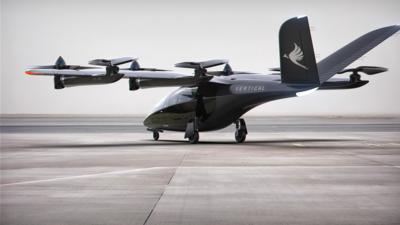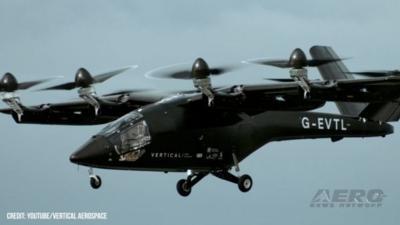Mon, Sep 16, 2024
Company Now Working With UK CAA for Flight Permit
Vertical Aerospace, a Bristol-based technology company working towards zero-emissions aviation, recently completed Phase I testing of its VX4 prototype. They are now working with the UK’s Civil Aviation Authority (CAA) to start untethered tests.

“It took us just one week to go from our first ground test to our chief test pilot flying the VX4, and we have been making outstanding progress since then,” commented Vertical Aerospace CEO Stuart Simpson. “We continue to prove the safety and performance of our design and technology, which we believe to be market-leading."
The Vertical VX4 features a 20% power-to-weight ratio increase from the previous model, allowing it to reach cruise speeds of 150 mph. It is a crewed Electric Vertical Take-Off and Landing (eVTOL) aircraft that can carry up to four passengers with “zero emissions.”
Phase I testing included multiple piloted tethered flights and ground runs for a total of 20 sorties at the Vertical Flight Test Center. These included Ground Vibration Testing (GVT), propeller spinning and balancing, parts checks, and a High Voltage (HV) ripple test. The company also analyzed the aircraft’s performance in run-up, taxi, tethered flight, and Electric Propulsion Unit (EPU) failure to ensure safety outside of its normal operation range. Vertical engineers collected and measured system parameters to verify that all systems were working correctly.

Vertical is continuing discussions with the UK CAA to prepare for Phase 2 testing. This will involve crewed VTOL and low-speed maneuver operations in thrustborne flight. Then, if successful, they will move into Phase 3 to test wingborne lift. Phase 4 will evaluate the shift from thrustborne to wingborne flight and back.
“Completing this first phase of testing is a significant feat for any eVTOL company and shows the strength of our aircraft, team, and our partners as we progress through our flight test program and head towards our goal of creating a better way to travel,” Simpson continued.
More News
From 2023 (YouTube Edition): "Ain’t Your Daddy’s Super Cub”—Don Wade Co-owned by Don and Ron Wade—the former of Don’s Dream Machines, a storied >[...]
Pilot-Rated Passenger Reported That The Pilot Did Not Adequately “Round Out” The Landing Flare And The Airplane Bounced And Yawed To The Right Analysis: The pilot state>[...]
Dead Reckoning Dead reckoning, as applied to flying, is the navigation of an airplane solely by means of computations based on airspeed, course, heading, wind direction, and speed,>[...]
Aero Linx: Lake Amphibian Club This website is created and sponsored by the Lake Amphibian Club, to help spread the word about these wonderful, versatile amphibians that can land j>[...]
“I am deeply honored to be sworn in as NASA administrator. NASA’s mission is as imperative and urgent as ever — to push the boundaries of human exploration, ignit>[...]
 Classic Aero-TV: In Praise of Alabamas Patriot Aircraft USA
Classic Aero-TV: In Praise of Alabamas Patriot Aircraft USA NTSB Final Report: Cirrus Design Corp SR22
NTSB Final Report: Cirrus Design Corp SR22 ANN's Daily Aero-Term (12.21.25): Dead Reckoning
ANN's Daily Aero-Term (12.21.25): Dead Reckoning ANN's Daily Aero-Linx (12.21.25)
ANN's Daily Aero-Linx (12.21.25) Aero-News: Quote of the Day (12.21.25)
Aero-News: Quote of the Day (12.21.25)




